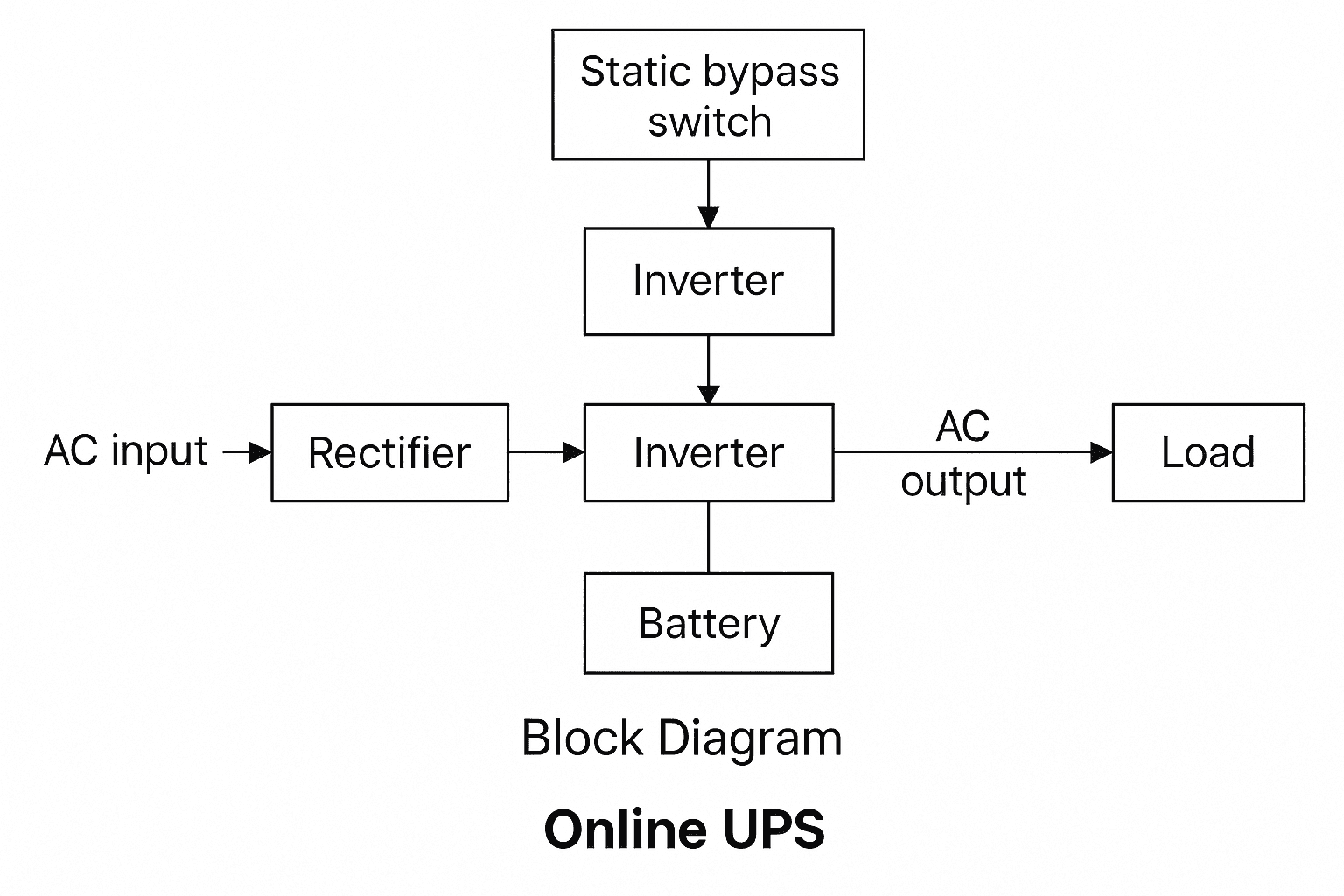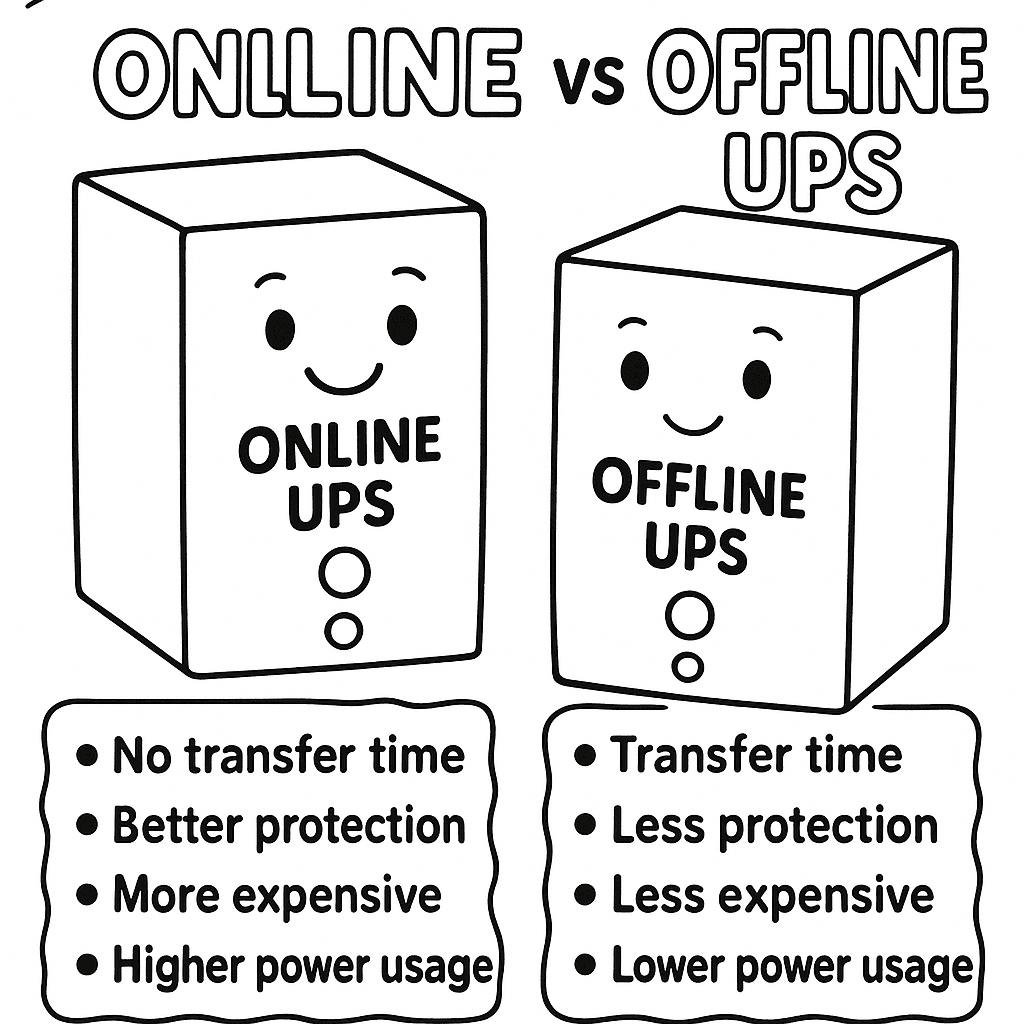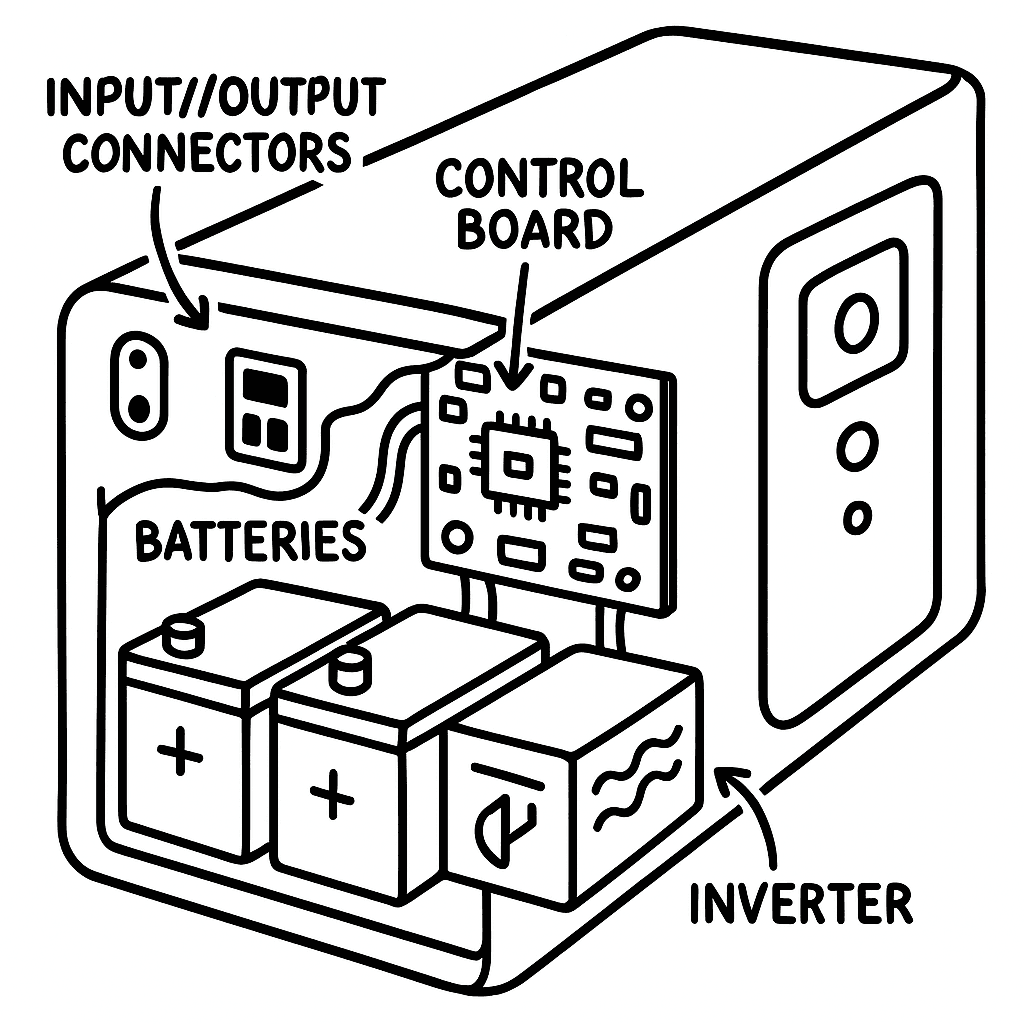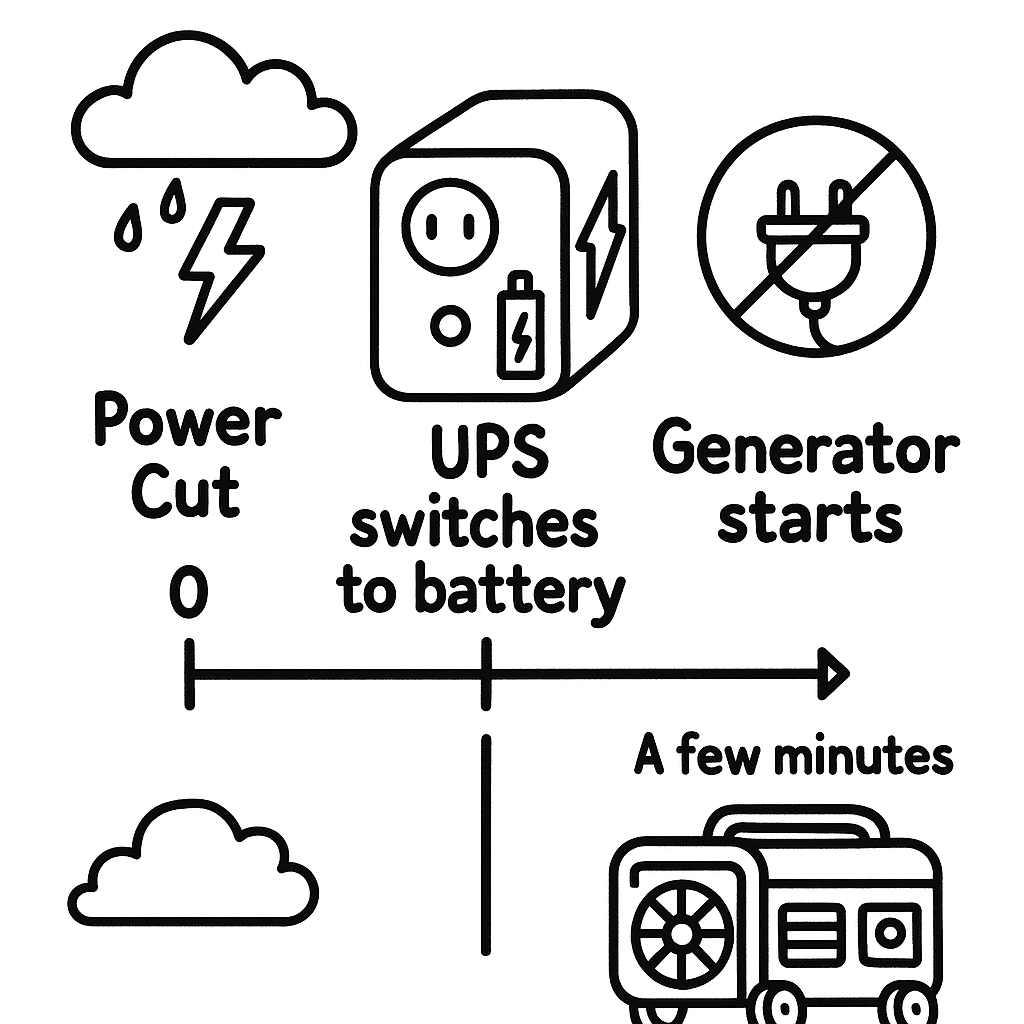Table of Contents
Electricity is the invisible energy that powers almost everything around us. From the smallest home appliance to the most advanced hospital life-support system—modern life relies entirely on electricity. But electricity is not always reliable. Power failures, voltage fluctuations, or even short interruptions can cause data loss, machine damage, or even life-threatening situations in critical areas like hospitals.
This is where a UPS—Uninterrupted Power Supply—becomes a real hero. It’s not just a backup device; it’s a smart electronic shield that guards your equipment against sudden power problems. Within milliseconds, a UPS takes over the job of supplying power, ensuring that nothing shuts down unexpectedly.
The UPS silently watches over your systems. It keeps your computers alive during blackouts, ensures medical machines continue to run, and allows industrial processes to complete safely. In simple words, the UPS is the safety net for your power supply.
In this guide, we’ll explore everything you need to know about a UPS—from what it is and how it works to why it’s so important for safety and stability in today’s electronic world.
What is a Uninterrupted Power Supply ( UPS)?
A UPS (Uninterrupted Power Supply) is a device that gives instant backup power to systems when the main power supply fails or fluctuates. It acts as a bridge between the moment the electricity goes out and the time a generator (if available) starts or the power returns.
It is commonly used in:
- Computers and data centers
- Hospitals and medical equipment
- Industrial machines
- Emergency lighting systems
- Banking and financial systems
Even a fraction of a second of power loss can damage sensitive electronics or result in data loss. A UPS prevents this by switching to backup power within milliseconds.
Main Components of a UPS
A UPS is a well-engineered system with intelligent electronic parts that work in perfect harmony to ensure your devices keep running, even when the power goes out. Let’s dive deeper into each of these core components:
1. 🔁 Converter or Rectifier
- The rectifier is the first stage in an online UPS system. It takes the AC (Alternating Current) from the main power supply and converts it into DC (Direct Current).
- This DC power is used to charge the UPS battery and also supplies the inverter simultaneously.
- High-frequency rectifiers are now commonly used for better efficiency and power factor correction, making the system more reliable and energy-efficient.
2. 🔌 Inverter
- The inverter does the reverse of the rectifier—it converts DC back into AC to power the connected load.
- It remains active in online UPS systems even when the mains power is available, ensuring continuous and clean power delivery with zero transfer time.
- Advanced inverters use technologies like PWM (Pulse Width Modulation) and IGBT (Insulated Gate Bipolar Transistor) switching for smooth waveform output and reduced harmonic distortion.
3. 🔋 Battery
- The battery acts as the heart of the UPS. It stores DC energy and delivers it instantly when power is lost.
- Most UPS systems use sealed lead-acid or lithium-ion batteries, depending on the application.
- Battery health is vital. Parameters like charge level, internal resistance, and temperature must be regularly monitored to prevent failure during emergencies.
4. 🔀 Static Bypass Switch
- This is an automatic switch that transfers the load directly to the main power line if the inverter fails or is overloaded.
- It ensures uninterrupted supply even when internal UPS faults occur, protecting sensitive equipment from power loss.
- High-end UPS systems have microcontroller-based static switches for instant and reliable switching without human intervention.
Each of these components plays a unique role in delivering seamless power. Regular maintenance, real-time monitoring, and understanding how they work will help ensure your UPS functions flawlessly when it matters most.
Types of Uninterrupted Power Supply (UPS)
UPS systems are categorized based on how they handle power interruptions and maintain power quality. The two main types are Online UPS (Double Conversion UPS)and Offline UPS, each designed for different levels of protection and application needs.
1. Online UPS (Double Conversion UPS)
- This type of UPS continuously converts incoming AC power to DC and then back to AC using an inverter. This double conversion ensures that any disturbances in the main power supply—like voltage drops, surges, or frequency variations—are completely eliminated.
- There is absolutely no transfer time when switching to battery power because the inverter is always supplying the load.
- Applications: Mission-critical operations such as hospitals, data centers, industrial automation, and telecom systems where even a millisecond of power loss can be disastrous.
- Advantages: Clean and stable power, zero switching time, protection from almost all types of power issues.
2. Offline UPS (Standby UPS)
- In normal conditions, this UPS provides power directly from the main supply. When it detects a power failure or abnormal voltage, it switches to battery mode. This switchover usually takes 2–10 milliseconds.
- The inverter is idle most of the time and only activates when needed.
- Applications: Home PCs, basic office setups, and non-critical loads where a brief power interruption is acceptable.
- Advantages: Cost-effective, simple design, energy-efficient during normal operations.
Online vs Offline UPS: Comparison Table
UPS systems come in different designs. The two common types are Online (double-conversion) UPS and Offline (standby) UPS. The table below compares their key features, pros and cons, and typical uses.
| Aspect | Online UPS (Double Conversion UPS) | Offline UPS (Standby) |
|---|---|---|
| How it works | Power always flows through the UPS inverter. Incoming AC is converted to DC to charge the battery and then inverted back to AC for the load. | Mains AC power normally goes straight to the devices. The battery and inverter only turn on when main power fails. |
| Switching Time | Instant (0 ms) – no break in power. | Brief pause (a few milliseconds) when switching to battery power. |
| Power Quality | Provides very clean, stable power. Continuously isolates equipment from any line problems (spikes, sags). | Offers basic backup protection. If the main line is noisy or out of range, that disturbance may reach the load until the UPS switches on. |
| Efficiency | Lower efficiency because it’s always converting power (more energy loss as heat). | Higher efficiency in normal use, since it passes power directly until needed. |
| Cost | Higher initial cost (more complex electronics). | Lower cost (simpler design). |
| Typical Uses | Critical loads: data centers, medical equipment, servers that cannot tolerate any interruption. | Non-critical or less sensitive equipment: home PCs, small office devices, workstations. |
| Advantages (Pros) | No interruption ever; ideal for very sensitive or critical loads. | More affordable; efficient in daily use; good for general-purpose backup. |
| Disadvantages (Cons) | More expensive; runs hotter; batteries cycle more often (shorter battery life). | Brief power gap on failure; not ideal for extremely sensitive electronics or real-time equipment. |
Key Takeaway: Online UPS units give the best protection (no transfer delay) but at higher cost and lower efficiency. Offline UPS units are simpler and cheaper but have a tiny switch-over pause and less power conditioning. Choosing depends on how sensitive your equipment is and your budget.
Key Consideration for Selection
- If your systems cannot tolerate any interruption, use an Online UPS.
- If you need basic protection from short outages and voltage fluctuations, an Offline UPS is often sufficient.
Understanding your equipment’s sensitivity and the importance of uptime is essential when choosing the right UPS system.
Safety Measures for UPS Operation
To make sure your UPS works well and lasts long, follow these simple but important safety tips:
1. Maintain Room Temperature
Keep the UPS in a well-ventilated room with a stable temperature between 20°C and 22°C. Excessive heat can damage batteries and electronic parts.
2. Keep the Area Clean
Ensure the UPS area is free from dust, dirt, and moisture. Regular cleaning prevents overheating and protects sensitive components from damage.
3. Use Rubber Mats
Place rubber insulation mats around the UPS setup. This helps prevent electric shocks and increases user safety, especially in industrial or server room environments.
4. Monitor Battery Health
Check the battery status regularly. Watch for warning signs like swelling, leakage, or reduced backup time. Replace old batteries every 3–5 years or as needed.
5. Inspect Connections
Check all power cables and terminal connections. Tighten loose wires and replace damaged cords to avoid sparks, shorts, or fire risks.
6. Test the UPS Periodically
Simulate a power cut by unplugging the UPS briefly to see if it switches to battery mode. This ensures that your backup system is functional.
7. Record All Parameters
Keep a log of voltage, battery status, temperature, and any alerts. This helps in troubleshooting and long-term maintenance planning.
8. Avoid Overloading
Connect only essential equipment within the UPS’s rated capacity. Overloading may lead to overheating or sudden failure during power loss.
9. Install in a Dry, Stable Location
Avoid placing the UPS near windows, heaters, or water sources. Always install it on a firm, vibration-free surface.
10. Train Personnel
Ensure that operators or maintenance staff know how the UPS works and what to do during a failure. A trained person can respond faster and more safely in emergencies.
By following these practices, you can extend the life of your UPS and ensure it performs reliably when needed the most.
Suggested Visuals and Diagrams
Visual aids can make it easier to grasp how a UPS works. Here are some ideas for helpful diagrams or illustrations:
Block Diagram of an Online UPS: An illustration showing AC input going into the UPS, being converted to DC, charging the battery, and then inverted back to AC for the output. Label parts like the rectifier, battery, inverter, and load. This helps readers see the “always-on” power path.

Offline UPS Operation Flow: A two-part diagram or flowchart. On the left, show normal mode: AC mains to load and battery charging on the side. On the right, show power failure: a switch icon flips, and the battery/inverter powers the load. Arrows and simple labels (like “Mains On” vs “Mains Off”) make it clear how power flows change.

Comparison Graphic: An infographic comparing Online vs Offline UPS. For example, two cartoon UPS boxes side by side with bullet lists of their advantages/disadvantages. This visual summary complements the table above and helps readers remember key differences.

UPS Hardware Photo/Diagram: A labeled photo or cutaway of a typical UPS unit. Show where the batteries, control board, inverter, and input/output connectors are. Seeing the real components can demystify the technology.
Power Outage Timeline: A simple timeline chart illustrating what happens during a blackout. Mark “Power Cut” at time 0, then show “UPS switches to battery” instantly, and “Generator starts” a few minutes later. This underscores the UPS’s role in those crucial seconds after an outage.

Important Equipment Inside a UPS
A UPS is not just a black box—it’s a smart and powerful system filled with intelligent electronic parts that work together to protect your valuable equipment. Here’s a closer look at the key components inside a UPS:
1. ⚡ IGBT (Insulated Gate Bipolar Transistor)
Acts as a smart electronic switch. It allows efficient and fast switching of electrical power, ensuring stable output even during sudden load changes. IGBTs are vital for smooth operation and energy efficiency.
2. 🔋 Charging Card
Controls the charging of the battery. It manages how much current flows into the battery, preventing overcharging or undercharging. A well-functioning charging card ensures the battery stays healthy and ready.
3. 🧠 Drive Card
The brain of the UPS. It sends commands to other components like the inverter, charger, and battery. It monitors performance and handles automatic adjustments.
4. 🌀 Choke
A coil that helps filter out voltage spikes and electrical noise. It ensures a clean and stable power supply to your devices, protecting them from sudden surges.
5. 🔽 Step-Down Transformer
Reduces high input voltage to safer levels usable by connected devices. It allows the UPS to supply power at the correct voltage, even if input voltage varies.
6. 🔁 Rectifier
Converts AC (Alternating Current) to DC (Direct Current), which is needed to charge the battery. It plays a vital role in preparing power for storage and future use during outages.
Common Reasons Why UPS Fails
Even though UPS is designed for protection and reliability, it can still fail due to several preventable factors. Understanding these causes helps in taking proactive steps to ensure your system works efficiently when it’s needed the most.
🔁 Inverter Failures:
- Under Voltage – This happens when the input voltage supplied to the UPS is too low for the inverter to operate correctly. It may cause the inverter to shut down or switch to battery mode unnecessarily.
- Input Side Short – A short circuit in the input section can result from damaged cables, poor insulation, or faulty wiring. This causes instant failure and may damage the inverter circuit.
- Phase Reversed – If the phase and neutral lines are connected incorrectly, it can prevent the UPS from detecting input power properly or cause internal damage to sensitive components.
⚡ Converter or Rectifier Failures:
- Output Side Short – A direct short circuit at the output terminals or in connected equipment can overload the rectifier, trip safety protections, or permanently damage the UPS.
- Overload – Plugging in more devices than the UPS is rated for results in overheating, quicker battery drainage, or forced shutdown. Continuous overloading also reduces the life of components.
- Component Aging – Over time, key electronic components like capacitors, transistors, and diodes degrade, increasing the chances of malfunction. Regular service can detect and replace worn parts before failure occurs.
- Poor Ventilation – If the UPS system is placed in a hot or poorly ventilated area, it can overheat. Heat is one of the main enemies of electronic devices and can drastically shorten component life.
These failures can usually be prevented by:
- Conducting regular inspections and servicing.
- Using the UPS within its rated capacity.
- Installing the UPS in a clean, temperature-controlled environment.
- Ensuring proper wiring and load distribution.
- Replacing aging components before they fail.
By taking these steps, you can ensure your UPS delivers safe and reliable power backup whenever it is needed most.
Ideal Environment for UPS
UPS systems are highly sensitive to environmental conditions. Their operating room should be treated like a clean laboratory or control center. It must be free from dust, moisture, corrosive gases, and vibrations, as these elements can degrade electronic components over time.
Temperature plays a crucial role. The ideal ambient room temperature should be maintained between 20°C and 22°C, as recommended by industry standards. High temperatures can accelerate battery aging and reduce backup time, while very low temperatures may limit battery efficiency.
Additionally, proper air circulation and ventilation are vital to prevent overheating of internal components. Installing air conditioning units with humidity control and ensuring regular air filter maintenance can extend the UPS lifespan significantly.
By creating a clean, cool, and stable environment, you help the UPS perform at its best and reduce the risk of unexpected failures.
UPS Maintenance Checklist
Keeping a UPS in good shape helps ensure it will work when needed. Here’s an easy checklist:
- Place in a proper environment: Make sure the UPS is in a cool, dry location with good air flow. Avoid high temperatures, humidity, or dusty areas. Excess heat or moisture can damage batteries and electronics.
- Clean regularly: Dust can block cooling fans and vents. Every few months (or as needed), gently wipe dust from the UPS case, fans, and vents. This helps the UPS stay cool and run efficiently.
- Check the battery: Look at the battery status indicator or meter. If the UPS shows a low-battery warning or the battery is more than a few years old (most UPS batteries last about 3–5 years), plan to replace it. Check for any bulging, leaks, or unusual signs – these mean the battery needs attention.
- Test the UPS: Once in a while, simulate a power outage. (For example, unplug the UPS from the wall for a moment.) Confirm that the UPS switches to battery power and keeps the connected equipment running. If the equipment shuts down too quickly, the UPS may need service or a new battery.
- Inspect connections: Ensure all power cables, battery connectors, and outlets on the UPS are secure and undamaged. Tighten any loose plugs and replace frayed cords to avoid failures or sparks.
- Update and log: If your UPS has user-replaceable components or firmware (software), update them as recommended by the manufacturer. Keep a simple log of maintenance dates, battery changes, and test results. This record makes it easy to spot trends or know when parts are due for replacement.
Conclusion: Why UPS Matters More Than You Think
The UPS may look like a small box sitting quietly in a corner, but it holds a powerful responsibility. It protects your data, your machines, your work—and sometimes even lives.
Whether it’s a hospital saving lives, a bank securing transactions, or a student protecting project files, UPS is the silent guardian in the background.
So, respect your UPS. Maintain it. Monitor it. Clean it. Because when the lights go out, the UPS is the hero that keeps the world running.
FAQ
What is a UPS (Uninterrupted Power Supply)?
A UPS is a device that provides backup power when the main electricity goes off. It helps keep computers, machines, and important devices running without stopping suddenly.What is the difference between Online UPS and Offline UPS?
Online UPS:
Always supplies power through its battery.
No delay when the main power fails.
Best for sensitive equipment like servers or medical machines.
Offline UPS:
Gives power directly from the wall when electricity is normal.
Switches to battery only when power fails.
Slight delay during power change.
